Best Time to Visit Hampi: October to March 2025
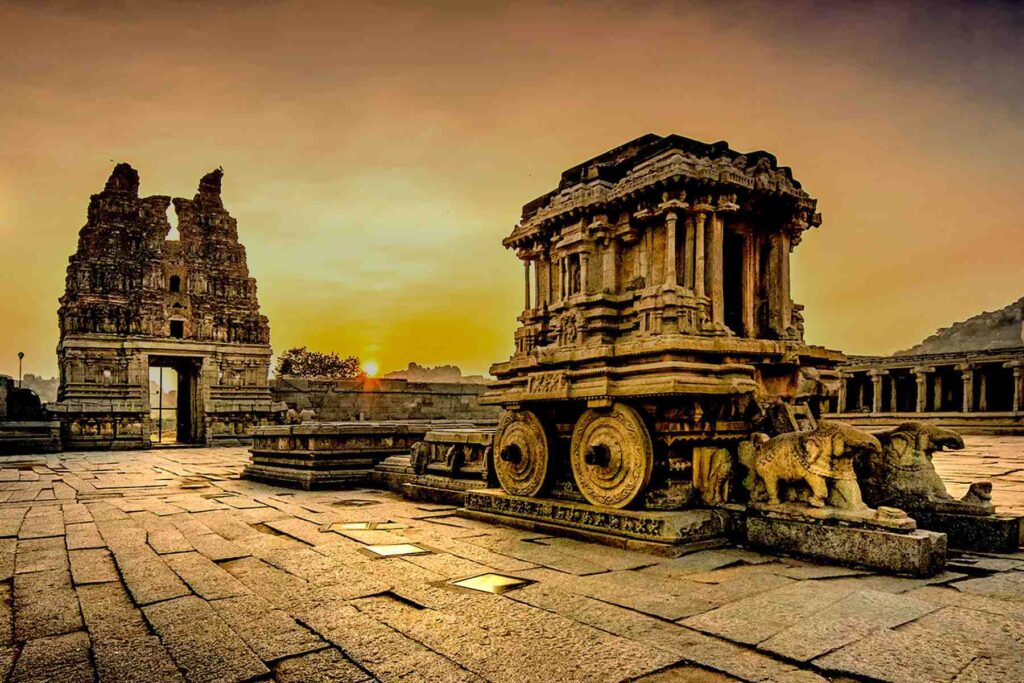
The best time to visit Hampi is during the winter season, from October to March. This time offers perfect weather for exploring the ancient city. Hampi is a UNESCO World Heritage Site known for its stunning temples and royal ruins. Whether you are a history enthusiast or simply love to explore architectural marvels, Hampi has something for everyone.
This TripzyGo guide will talk about the Hampi best season to visit, the temperature in each season, and places to visit in Hampi in 2 days. From the majestic Virupaksha Temple to the Hippie Island, explore what makes Hampbi a must-visit place. Before that, check out these some interesting facts about Hampi:
- Hampi is a UNESCO World Heritage Site. This historic place has a link to the Ramayana as Kishkindha.
- The Vittala Temple features 56 music pillars that produce melodic sounds when tapped gently.
- Hampi boasts more than 1600 structures that show Dravidian architecture
- House of royal families is spanning 59000 square meters
- Hazara Rama Temple has detailed carvings of scenes from the Ramayana
Best Time to Visit Hampi: Overview

The best time to visit Hampi is between October and March. This time, the weather is pleasant, and the surroundings are flourishing after the monsoon. This season is also filled with some festivals that reflect the cultural beauty of Hampi. Let’s explore each season and temperature to help you plan your trip better:
October to March: Peak Season
- The temperature ranges from 16°C to 32°C, offering pleasant days and a breezy evening.
- Post-monsoon, add more green color to Hampi.
- Enjoy the Hampi Festival in November and Purandarasa Aradhana in January and February. In October, celebrate Diwali in style, and in December, take part in the Phalpuja Festival.
July to September: Moderate Season
- Temperature from 25°C to 33°C, make the days cooler
- Light to moderate rainfall adds charm to monuments
- With high humidity, outdoor activities become slightly uncomfortable
April to June: off-Season
- The temperature is on peak between 30°C and 38°C, with dry and hot days
- Virupaksha Car Festival adds a cultural highlight
- Hotel and stay are available at discounted price
The Best Season to Visit Hampi is Winter (October to March)
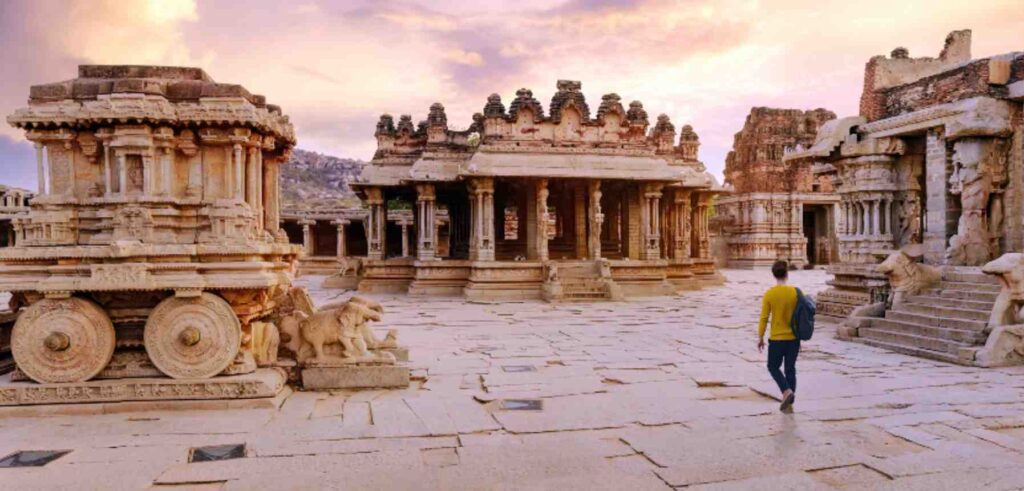
Winter is undoubtedly the best season to visit Hampi, with temperatures between 16°C and 32°C. The pleasant days and cool breeze make the sunset most beautiful. You can enjoy river cruising on the Tungabhadra River, where the water level is ideal, and post-greenery enhances the beauty of landscapes.
The weather is comfortable enough to climb the iconic boulders or take long walks through the ancient temples and markets. What makes this season more special is the vibrant atmosphere cherished with festivals. The Hampi festival (Vijay Utsav) in November is a grand celebration. Folk music, dance performances, and art exhibitions add a cultural touch to the festival.
Similarly, the Purandara Festival in January-February brings together classical music lovers to celebrate the works of the medieval poet-composer Purandaradasa. History, colorful culture, and soaking in natural beauty- winter truly makes Hampi alive and makes it the best time to visit.
Hampi in Monsoon: July to September
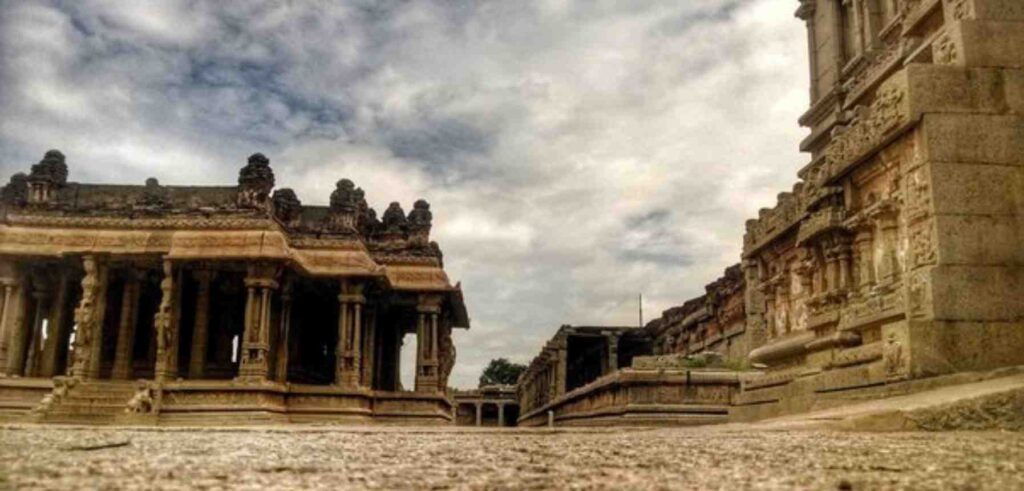
Monsoons bring freshness to Hampi, with temperatures ranging from 25°C to 33°C. Low to moderate rainfall converts the terrain into lush greenery, making the ruins even more magical. While rock climbing is not recommended due to slippery boulders, you can enjoy peaceful and budget-friendly stays. It is a quieter time to explore history in solitude!
Hampi in Summer: April to June
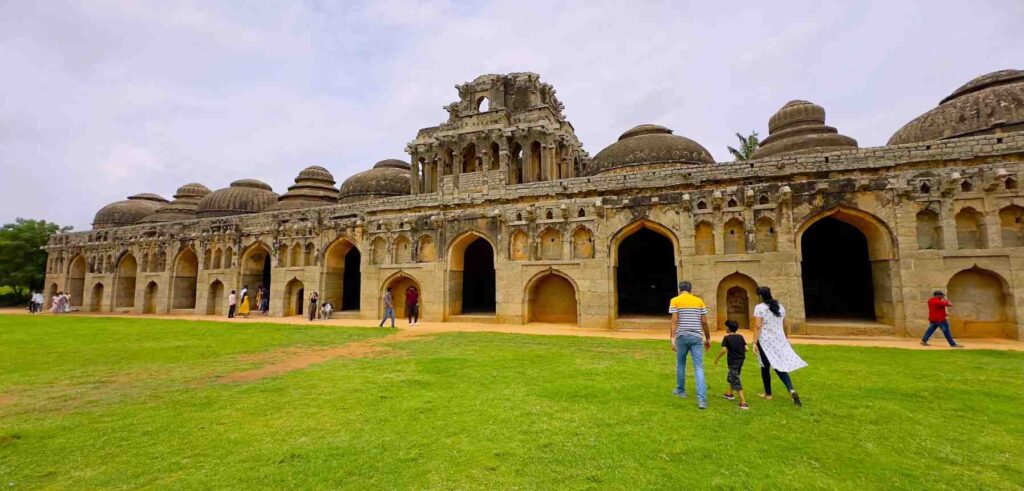
Summer in Hampi is really hot, and the temperature soars between 30°C and 38°C, making you sweaty. However, this time is ideal for budgeting as discounts on accommodations make it affordable. Additionally, the Virupaksha Car Festival, celebrated in March or April, is a major draw. This grand celebration marks the divine marriage of Lord Shiva and Goddess Parvati. It offers a chance to experience Indian culture despite the heat.
Places to Visit in Hampi in 2 Days
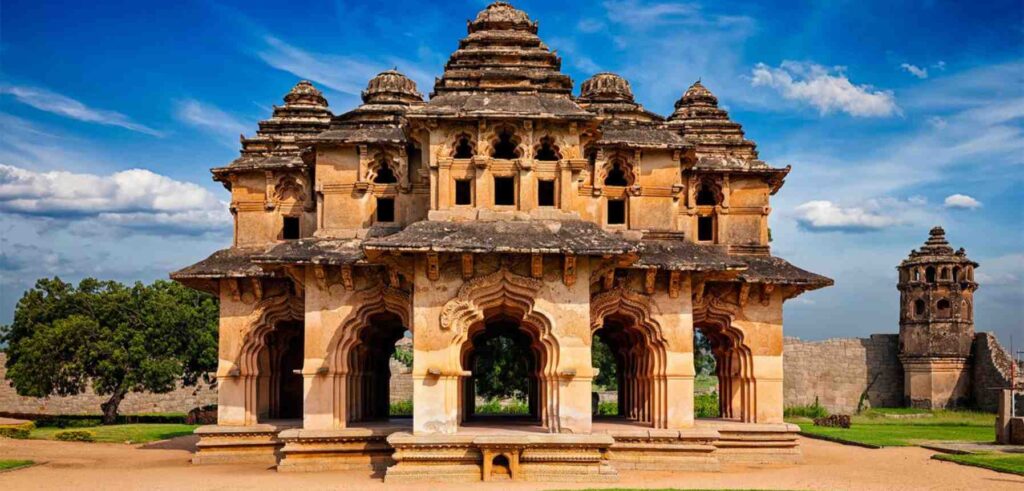
Hampi, a UNESCO World Heritage Site, is one of the historical places in Karnataka. It is known for its rich history and architectural wonders and offers a perfect blend of culture and serenity. While exploring the best time to visit Hampi, these nearby attractions in Hampi are must-visits:
Virupaksha Temple, Hampi (1km from the city center)
The Virupaksha Temple in Hampi, dating back to the 7th century, is dedicated to Lord Shiva in his form as Virupaksha. This UNESCO World Heritage Site is known for its towering 9-story eastern gopuram, intricate carvings, and the sacred Ranga Mandapa. The rich history of the temple and its connection to Lord Shiva and Parvati make it a spiritual and cultural marvel.
Vithala Temple (1km from the city center)
The Vithala Temple in Hampi is a must-see architectural marvel, famous for its musical pillars and Stone Chariot. It was built in the 15th century, showcasing Dravidian architecture. The Ranga Mantapa is home to the 56 musical pillars, which produce beautiful sounds when tapped gently.
Other than these pillars, Maha Mantaoa is decorated with stunning carvings, and the Kalyana Mantapa is the center of attraction. A visit to this temple offers a perfect blend of history, art, and mystery.
Lotus Palace (2 km from the city center)
The Lotus Mahal is also known as Kamal Mahal or Chitrahani Mahal. A stunning architectural marvel in Hampi, located within the royal women’s quarters of the Vijayanagara Empire, has a unique design that resembles a lotus bud and blends Islamic and Indian architectural styles.
The two-storied palace is symmetrical, with 24 pillars that support arched windows and balconies. Visiting the Lotus Mahal costs INR 10 for Indians and INR 250 for foreign tourists. Children under 15 years enter for free, and it is open daily from 8 am to 6 pm.
Yantrodharaka Hanuman Temple (4 km from the city center)
The Yantrodharaka Hanuman Temple, located on Anjaneya Hill, is one of the must-visit sites in Hampi. It was built by Sri Vyasaraja, the Rajguru of the Vijayanagara Empire, 500 years ago. It is believed that this is the place where Lord Rama and Lord Hanuman met for the first time.
The temple is famous for its unique Hanuman idol, which is in a meditative state, surrounded by twelve monkey idols. These monkeys symbolize twelve days of prayer. Vyasraja used to draw Lord Hanuman’s image with charcoal, which vanished after each ritual, telling of divine interventions. The temple is a testament to faith and devotion!
Hampi Bazaar
Hampi Bazaar, located in front of the Virupaksha Temple, offers a peek into Hampi’s past as a bustling market. Although it is much quieter now, you can still wander through its old pavilions, shop local handcrafts and embroidered textiles, and simply enjoy a morning stroll. The Bazaar comes alive during the Hampi Utsav in November and turns into the hub of festivities and culture.
Hippie Island (1km from the city center)
When you visit Hampi, do not miss the chance to explore Hippie Island (Virupapur village). It is totally different from Hampi, as Hampi reflects its rich history, while this island offers green landscapes.
Hippie Island is known for its relaxed atmosphere, which is a favorite among backpackers. You can stay in cozy huts and enjoy a mix of Indian and Western food. After exploring Hampi’s ancient temples, Hippie Island is the perfect place to relax and soak in the scenic beauty.
Queen’s Bath (2 km from the city center)
The Queen’s Bath in Hampi is a beautiful piece of history, built over 500 years ago for the royal family. It looks simple outside but stunning inside, with a large bath surrounded by arched corridors and delicate balconies.
The bath is open to the sky, fed by an ancient aqueduct system, and protected by a moat. Today’s exploration of the best time to visit Hampi offers a glimpse into Hampi’s royal past and architectural beauty.
Elephant Stables (1km from the city center)
The Elephant Stables were built in the 15th century during the Vijayanagara Empire. These are stunning examples of Ibkndo-Islamic architecture. This long rectangular structure houses 11 domed chambers. Each chamber is large enough to shelter two royal elephants.
The central one stands out with carvings that reflect the grandeur of Hampi’s temples. Smaller chambers are interconnected with arched doors. A well-preserved stables highlight the craftsmanship of that time and show the significance of its elephant army. It is a must-visit spot when exploring the best places to visit in the monsoon season in Karnataka.
Sanapur Lake (27.4 km from the city center)
A nature escape in the midst of Hampi’s landscape, Sanapur Lake is perfect for a relaxing break. You can enjoy coracle rides and sunrise and sunset views, or try cliff jumping for a thrilling experience. Swimming spots are limited due to crocodiles. There are no nearby restaurants, but locals sell refreshments like chilled beers.
Monolith Bull (1km from the city center)
It is also known locally as Yeduru Basavanna, and it is a remarkable symbol of devotion and heritage. The massive Nandi statue, Shiva’s mount, faces the Virupaksha Temple at the other end of the Virupaksha Bazar. The pavilion, surrounded by boulders, adds a rustic charm and makes it one of the places to visit in Hampi in two days.
Witness the History During the Best Season (October-March) to Visit Hampi
October to March is the best time to visit Hampi, as the weather is pleasant and soothing, with a cold breeze. Lush landscapes and vibrant festivals create the perfect setting to witness the history of Hampi. From the towering Virupaksha Temple to the unique Lotus Mahal, every corner of Hampi tells a story. Plus, with the rich historic atmosphere and festivals in full swing, there is no better time to immerse yourself in Hampi. What are you waiting for? Pack your bags and get ready to experience the magic of Hampi with a travel partner like TripzyGo!

